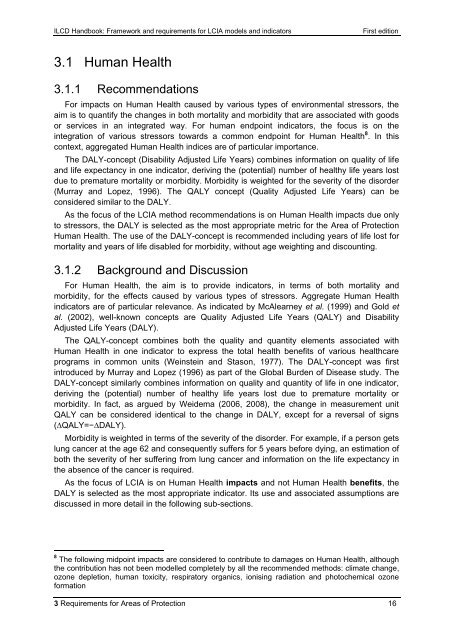ILCD Handbook: Framework and requirements for LCIA models and ...
ILCD Handbook: Framework and requirements for LCIA models and ...
ILCD Handbook: Framework and requirements for LCIA models and ...
Create successful ePaper yourself
Turn your PDF publications into a flip-book with our unique Google optimized e-Paper software.
<strong>ILCD</strong> <strong>H<strong>and</strong>book</strong>: <strong>Framework</strong> <strong>and</strong> <strong>requirements</strong> <strong>for</strong> <strong>LCIA</strong> <strong>models</strong> <strong>and</strong> indicators First edition<br />
3.1 Human Health<br />
3.1.1 Recommendations<br />
For impacts on Human Health caused by various types of environmental stressors, the<br />
aim is to quantify the changes in both mortality <strong>and</strong> morbidity that are associated with goods<br />
or services in an integrated way. For human endpoint indicators, the focus is on the<br />
integration of various stressors towards a common endpoint <strong>for</strong> Human Health 8 . In this<br />
context, aggregated Human Health indices are of particular importance.<br />
The DALY-concept (Disability Adjusted Life Years) combines in<strong>for</strong>mation on quality of life<br />
<strong>and</strong> life expectancy in one indicator, deriving the (potential) number of healthy life years lost<br />
due to premature mortality or morbidity. Morbidity is weighted <strong>for</strong> the severity of the disorder<br />
(Murray <strong>and</strong> Lopez, 1996). The QALY concept (Quality Adjusted Life Years) can be<br />
considered similar to the DALY.<br />
As the focus of the <strong>LCIA</strong> method recommendations is on Human Health impacts due only<br />
to stressors, the DALY is selected as the most appropriate metric <strong>for</strong> the Area of Protection<br />
Human Health. The use of the DALY-concept is recommended including years of life lost <strong>for</strong><br />
mortality <strong>and</strong> years of life disabled <strong>for</strong> morbidity, without age weighting <strong>and</strong> discounting.<br />
3.1.2 Background <strong>and</strong> Discussion<br />
For Human Health, the aim is to provide indicators, in terms of both mortality <strong>and</strong><br />
morbidity, <strong>for</strong> the effects caused by various types of stressors. Aggregate Human Health<br />
indicators are of particular relevance. As indicated by McAlearney et al. (1999) <strong>and</strong> Gold et<br />
al. (2002), well-known concepts are Quality Adjusted Life Years (QALY) <strong>and</strong> Disability<br />
Adjusted Life Years (DALY).<br />
The QALY-concept combines both the quality <strong>and</strong> quantity elements associated with<br />
Human Health in one indicator to express the total health benefits of various healthcare<br />
programs in common units (Weinstein <strong>and</strong> Stason, 1977). The DALY-concept was first<br />
introduced by Murray <strong>and</strong> Lopez (1996) as part of the Global Burden of Disease study. The<br />
DALY-concept similarly combines in<strong>for</strong>mation on quality <strong>and</strong> quantity of life in one indicator,<br />
deriving the (potential) number of healthy life years lost due to premature mortality or<br />
morbidity. In fact, as argued by Weidema (2006, 2008), the change in measurement unit<br />
QALY can be considered identical to the change in DALY, except <strong>for</strong> a reversal of signs<br />
(∆QALY=−∆DALY).<br />
Morbidity is weighted in terms of the severity of the disorder. For example, if a person gets<br />
lung cancer at the age 62 <strong>and</strong> consequently suffers <strong>for</strong> 5 years be<strong>for</strong>e dying, an estimation of<br />
both the severity of her suffering from lung cancer <strong>and</strong> in<strong>for</strong>mation on the life expectancy in<br />
the absence of the cancer is required.<br />
As the focus of <strong>LCIA</strong> is on Human Health impacts <strong>and</strong> not Human Health benefits, the<br />
DALY is selected as the most appropriate indicator. Its use <strong>and</strong> associated assumptions are<br />
discussed in more detail in the following sub-sections.<br />
8 The following midpoint impacts are considered to contribute to damages on Human Health, although<br />
the contribution has not been modelled completely by all the recommended methods: climate change,<br />
ozone depletion, human toxicity, respiratory organics, ionising radiation <strong>and</strong> photochemical ozone<br />
<strong>for</strong>mation<br />
3 Requirements <strong>for</strong> Areas of Protection 16



